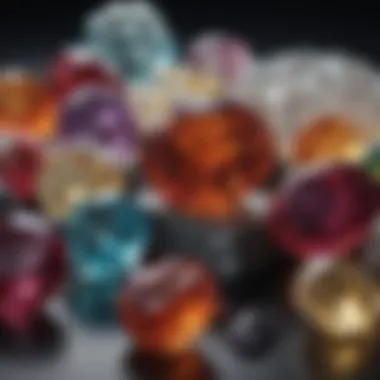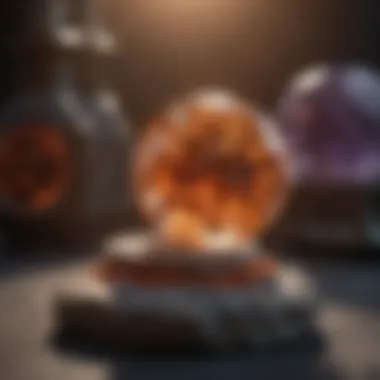Gemstone Storage: Best Practices for Care and Preservation


Intro
Gemstone storage is a critical area of gemstone care that often does not receive due attention from collectors and enthusiasts alike. Understanding how to preserve these natural treasures goes beyond the aesthetic value they hold; it encompasses their unique physical and chemical properties, which demand specific conditions for optimal maintenance.
This section will lay the foundation for the subsequent discussion on essential storage practices, offering insights that are relevant not only for collectors but also for jewelry designers and geology aficionados.
Gemstones vary widely in their composition, hardness, and coloration, which influence how they should be stored. Therefore, grasping the fundamental characteristics of gemstones allows one to identify their vulnerabilities and devise appropriate storage solutions that ensure their longevity. Aimed at providing knowledge on various techniques, this article addresses the environmental factors, material choices, and the potential consequences of inadequate storage.
The following sections will detail these pivotal aspects, facilitating a deeper understanding of how to care for and preserve gemstone collections effectively.
Prelude to Gemstone Storage
Gemstone storage is a critical aspect of maintaining the allure and longevity of any collection. An understanding of how to properly store gemstones is essential for both collectors and jewelry designers. This knowledge not only preserves the aesthetic appeal of these treasures but also safeguards their monetary value. The unique properties of individual gemstones dictate specific storage requirements, making it paramount to tailor methods according to each type.
Proper storage can prevent a range of issues, from physical scratches to tarnishing and degradation over time. One careless act can lead to irreversible damage. Thus, ensuring correct storage conditions is vital for keeping gemstones in pristine condition.
Importance of Proper Storage
Proper storage of gemstones significantly impacts their lifespan and visual appeal. Gemstones can be remarkably delicate, each possessing distinct characteristics that influence how they should be cared for. For instance, soft stones like opal may easily scratch, while harder ones, like diamond, are more resistant to wear but still require attention to their setting and environmental exposure.
Adequate storage methods protect against dust accumulation, moisture, and accidental damage while allowing for easy organization of one’s collection. The financial investment made in gemstones necessitates a commitment to maintaining them, as their values can fluctuate based on condition and market trends. Thus, a systematic approach to storage not only contributes to longevity but also adds to the overall enjoyment of the collection.
Understanding Gemstone Characteristics
Each gemstone exhibits unique traits that affect how it should be stored. Factors such as hardness, durability, and susceptibility to environmental factors vary widely among types. For example, emeralds, known for their beauty, are also softer and require special care when being stored to prevent scratches. In contrast, sapphires are more resilient, but they can still benefit from being stored separately to avoid damage.
Characteristics to consider include:
- Hardness: Measured on the Mohs scale, this determines how easily a stone can be scratched.
- Toughness: Relates to a gemstone’s ability to withstand wear.
- Stability: Some gemstones, like amethyst, can fade in sunlight, requiring caution in light exposure during storage.
Understanding these features helps in making informed decisions about which storage solutions to employ. It forms the basis for selecting materials and practices that will enhance and protect the integrity of the collection.
Environmental Factors Affecting Gemstones
Understanding the environmental factors that can impact gemstones is crucial for their preservation. Gemstones, while known for their beauty and durability, are sensitive to their surroundings. Several external conditions can affect their structure and aesthetic qualities, ultimately influencing the longevity of a collection. Paying attention to these factors ensures that gemstones remain in optimal condition, safeguarding an investment that can carry significant value.
Humidity Levels
Humidity plays a significant role in gemstone preservation. When storing gemstones, it is essential to maintain a stable humidity level. High humidity can promote the growth of mold and mildew, particularly in organic gemstones like pearls and amber. Conversely, low humidity can lead to drying out, especially in gemstones that are porous. An ideal relative humidity level is between 40% and 50%. Utilizing a hygrometer can help monitor the humidity levels in your storage space. If necessary, consider using a humidifier or dehumidifier to create a more controlled environment. Proper humidity maintenance will help protect the integrity of the gemstones.
Temperature Control
Temperature fluctuations can also be detrimental to gemstones. Extreme temperature changes can cause them to expand and contract, which may lead to fractures or color changes. The recommended storage temperature is typically between 60°F and 75°F (15°C to 24°C). It is advisable to avoid storing gemstones in areas exposed to direct heat sources or in areas subject to extreme cold, such as basements or attics. Regular monitoring of the temperature using a thermometer is wise. Keeping gemstones in a stable temperature environment will help preserve their color, clarity, and brilliance over time.
Light Exposure
Light exposure significantly affects gemstones, especially colored ones. Ultraviolet (UV) light can fade and alter the appearance of certain stones, damaging them permanently. For instance, amethyst and citrine are particularly sensitive to light exposure, and prolonged exposure can diminish their vibrancy. Store gemstones in a dark area or utilize display cases designed with UV protection. If showcasing gemstones, consider using lighting that minimizes UV rays. By being mindful of light exposure, gemstone owners can maintain the beauty and value of their collections.
Important Note: The attention paid to humidity levels, temperature control, and light exposure will directly impact the quality and longevity of gemstones. Ignoring these factors can lead to irreversible damage and diminish the aesthetic qualities of your beautiful stones.


Types of Gemstone Storage Solutions
Gemstone storage solutions are crucial for preserving the beauty and integrity of collections. The right storage methods prevent physical damage, environmental deterioration, and ensure easy access to these precious items. Various options are available, each with unique advantages and considerations. Choosing the best solution depends on the specific needs of the gemstones and the preferences of the collector.
Jewelry Boxes
Jewelry boxes are not just aesthetic; they serve a protective function as well. High-quality jewelry boxes are lined with soft materials to prevent scratching. They often contain separate compartments, which keep individual pieces from coming into contact with one another. This is important to avoid scratches or potential chemical reactions that could occur between different metals or stones.
When selecting a jewelry box, consider the material used. Wooden boxes can offer a classic look and durability, while plastic boxes might be lighter and more affordable. Some boxes are equipped with locks for added security, which can be a critical feature for valuable collections.
Display Cases
Display cases allow gemstone enthusiasts to showcase their collections while providing protection from dust and damage. These cases come in various designs, from simple glass boxes to elaborate cabinets. The insertion of UV filtering glass is beneficial in preventing sunlight from fading the colors of gemstones. An effective display case strikes a balance between visibility and security, being easy to access but also secure from unauthorized handling.
Settings that display cases should avoid include direct sunlight, as fading can occur. Placement also matters; the case should not be in areas with significant temperature fluctuations. A stable environment helps maintain the quality of the stones on display.
Soft Pouches
Soft pouches provide a flexible and cost-effective solution for gemstone storage. They are especially advantageous for travel. These pouches can be made from materials like velvet, satin, or microfiber. They protect gemstones from scratching against hard surfaces while allowing for safe transport.
However, one should use soft pouches with caution. They should not be used for long-term storage of high-value stones unless they are inside another protective case or container. Exposure to moist air can lead to mold or deterioration over time. Thus, while they serve a good initial purpose, they can be limited in long-term applications.
Hard Cases
Hard cases offer the ultimate protection for gemstones, especially during transport. Made from robust materials, these cases are often waterproof and impact-resistant. Many hard cases come with internal padding, specifically designed to hold gemstones securely in place during movement.
Choosing a hard case should factor in the size and weight. There may be options with customizable inserts for more personalized organization. These cases work well for traveling gemstone collectors or for those who frequently attend trade shows. However, they are not as visually appealing for home storage as jewelry boxes or display cases may be.
Proper selection of storage solutions is essential for maintaining the aesthetic and intrinsic value of gemstones over time.
Understanding these various storage options can help collectors make informed decisions that protect their gemstones. Each type of storage solution has its distinct purpose and benefits, making it vital to assess individual needs when organizing a collection.
Dos and Don'ts of Gemstone Storage
The section on Dos and Don'ts of Gemstone Storage is critical for preserving the integrity of your gemstones. Improper storage practices can lead to deterioration, scratches, and loss of value. By understanding the right methods, you ensure your collection remains beautiful and intact for years to come. The following subsections explore essential considerations for effective gemstone storage.
Handling Precautions
Proper handling is vital in storing gemstones. Always wash your hands before touching them to remove oil or dirt that can cause damage. For added safety, wear cotton gloves while handling to prevent fingerprints that might lead to tarnishing. Additionally, handle loose gemstones with care, holding them by their edges. Avoid gripping them too tightly, as this can result in unintentional pressure on the stone and compromise its structure.
- Use a soft surface: Always place gemstones on a soft surface, like a clean cloth, to prevent scratches.
- Avoid sudden movements: Move slowly and deliberately to reduce dropping risks.
Avoiding Scratches and Damage
Gemstones are often delicate, making them susceptible to scratches and other forms of damage. It is essential to store them correctly to minimize risk. Do not place gemstones loosely in a box or drawer, as they can bump against one another, causing significant harm. Instead, opt for solutions such as individual compartments or dividers in your storage.
- Keep soft stones separate: Store softer gemstones, like opals and pearls, away from harder stones like diamonds.
- Use protective wrapping: When not in use, wrap gemstones in soft, lint-free cloths before placing them in storage.
Remember: Regular checks on your gemstone storage can help identify potential issues early, before they escalate.
When to Clean Gemstones


Cleaning gemstones should be done cautiously and sparingly. Over-cleaning can strip away the protective coatings sometimes applied to enhance appearance. It is recommended to clean gemstones only when there is noticeable dirt or residue.
- Assessment before cleaning: Check for grime buildup or dullness which might indicate it is time for a clean.
- Cleaning methods: Use mild soap and warm water, avoiding harsh chemicals that can ruin the gemstone’s surface. A soft brush can help remove dirt without scratching.
Conducting these practices diligently can enhance the longevity of your collection, providing not just visual appeal but also preserving their intrinsic value.
Optimal Conditions for Storage
Proper storage of gemstones requires attention to the conditions within which they are kept. This section addresses vital factors that contribute to effective gemstone preservation. Creating an optimal storage environment helps maintain the integrity, color, and clarity of gemstones, making it an essential consideration for collectors and enthusiasts alike.
Creating a Controlled Environment
A controlled environment is crucial for the longevity of gemstones. Factors such as temperature, humidity, and light exposure must be managed. Storing gemstones in a consistent temperature zone helps prevent damage caused by thermal expansion or contraction. Ideally, temperatures should be kept between 60°F to 75°F (15°C to 24°C).
Humidity is another important element. Excess moisture can lead to mold and damage, while too little humidity can cause stones to crack. An ideal humidity level should range from 40% to 60%, preventing adverse effects on the gemstones.
Utilizing storage containers that are opaque and well-sealed can further protect gemstones from environmental variations. Wooden or padded boxes can buffer against shock and provide insulation from temperature changes.
Use of Desiccants
Integrating desiccants into your gemstone storage practices is advisable. Desiccants are substances that absorb moisture, helping to maintain that delicate balance of humidity mentioned earlier. Common options are silica gel and activated charcoal. Placing small packets of these materials in your storage containers can effectively minimize humidity, thus preserving your stones.
It is essential to check and replace desiccants periodically, especially in more humid climates or environments prone to moisture. Regularly renewing desiccants ensures that the protective qualities are maintained, offering continual care for your gemstones.
Keeping a consistent environment and using desiccants not only preserves the gemstones but also aids in maintaining their market value over time.
By adhering to these practices, you greatly enhance the capacity for gemstones to withstand the tribulations of time and environmental influence.
Organizing a Gemstone Collection
Organizing a gemstone collection is crucial for both preservation and appreciation of these valuable assets. Knowing how to categorize stones not only helps in maintaining their condition but also facilitates easier access when needed. Additionally, a well-organized collection visually enhances the appeal of your gems, making them more enjoyable to admire.
Categorization by Type
The first step in organizing is categorization. Grouping gemstones by type allows collectors to quickly locate specific items. This can be achieved through several methods:
- By mineral type: Group stones like diamonds, rubies, sapphires, and emeralds separately. This is practical because each mineral has distinct properties and care requirements.
- By color: Some collectors prefer to arrange their gemstones by color. This method creates a rainbow effect and can highlight the unique characteristics of each stone.
- By size or carat weight: For some, sizing gemstones is essential. Larger pieces often deserve special attention, thus this kind of categorization may aid in managing space and condition better.
- By origin: Knowing the source of a gem can be informative. Collecting stones from specific regions or countries allows enthusiasts to appreciate geological variety and rarity.
Taking the time to develop a clear system of categorization maximizes efficiency and enhances the collection's overall management. It is also beneficial for insurance purposes, providing clearer documentation of what is owned.
Notating Conditions and Appraisals
Another essential aspect of organizing a gemstone collection includes detailed notations regarding each stone's condition and its appraised value. Accurate records are vital for several reasons:
- Monitoring condition over time: Regular assessments can highlight changes due to environmental factors or handling. This ensures preventative measures can be adopted promptly.
- Facilitating maintenance: Knowing if a stone requires cleaning or appraisal at a particular time can streamline care routines, helping to maintain gemstone integrity and value.
- Insurance and resale: Documented appraisals are necessary for claiming value during any loss or damage claims. Similarly, detailed records simplify selling or trading stones in the future.
In practice, this could involve maintaining a log that includes:
- The type of gemstone
- Its current condition
- Appraised value
- Any noted repairs or maintenance suggestions
Future collectors can greatly benefit from this thorough approach, as it lays a foundation for responsible stewardship of these precious items.


Avoiding Common Storage Mistakes
Proper storage of gemstones is as crucial as the selection or purchasing process. Understanding common storage mistakes can save enthusiasts from potentially costly damages. Neglecting these details may lead to diminished quality and aesthetics of the gemstones over time.
Storing with Other Materials
One common mistake gemstone collectors make is storing gemstones with other materials, such as metals or other gemstones. This practice can lead to physical damage from scratches or abrasions. Each material may have different hardness levels, resulting in harder gemstones scratching the softer ones.
It is essential to keep gemstones separated. Individual containers, even if they are small fabric pouches, can prevent physical contact and subsequent damage. Consider using compartmentalized jewelry boxes or specialized cases. This not only minimizes the risk of scratching but also makes it easier to locate specific gemstones within the collection.
Ignoring Repair Needs
Ignoring repair needs is another grave mistake. Many gemstones may require maintenance over time. Loose settings, worn clasps, or weak links can lead to lost stones. Regular inspections are essential. Cultivating a habit of checking for signs of damage can prevent unwanted loss or damage.
Furthermore, it is advisable to address repairs promptly. When a gemstone is damaged, the urgency diminishes, but it cannot be overlooked. Leaving a damaged piece unattended may exacerbate the situation. Seek professional advice or services before permanent harm takes place.
By focusing on separating gemstones and attending to repair needs promptly, collectors can substantially improve the longevity and quality of their gemstone collection. Keeping in mind these practices minimizes common yet preventable errors.
Traveling with Gemstones
When embarking on a journey, particularly for gemstone enthusiasts and collectors, the transportation of valuable gems necessitates careful planning and consideration. Protecting these treasures while traveling is not merely a precaution; it is a fundamental practice to ensure their preservation. Safe travels with gemstones involve not only the selection of appropriate containers but also consideration for potential risks such as theft, loss, or damage during transit. The right approach can greatly enhance the confidence of any traveler carrying their gem collection.
Choosing the Right Container
Selecting a proper container for gemstones during travel is crucial. The container should provide adequate protection against physical impacts and environmental factors. Here are key features to look for when choosing a container:
- Padding: Soft lining or padding inside the container keeps stones secure and helps to prevent scratches. Look for materials like velvet or microfiber.
- Durability: Opt for hard cases made from robust materials such as aluminum or high-impact plastic. These structures offer better protection against crushing or breaking.
- Size and Compartmentalization: A container that has compartments helps to separate individual gemstones, reducing risk of contact that can lead to scratches or chips.
- Water Resistance: A water-resistant case is a wise choice, especially in unpredictable weather. This prevents moisture damage.
Additionally, consider portability. Your container should be lightweight and easy to carry, without compromising on security.
Insurance Considerations
Traveling with valuable gemstones also raises the issue of adequate insurance coverage. This aspect is often overlooked but is critical for peace of mind. To safeguard your collection:
- Inventory Documentation: Before traveling, create an inventory list of your gemstones. Include photographs and details like size, weight, and valuation if available.
- Talk to Your Insurer: Contact your insurance provider to discuss coverage options during travels. Some policies cover gemstones only while they are at home. Ensure that your insurance extends to cover loss or theft while traveling.
- Transport with Care: Make sure to store your gemstones in their designated case rather than in your pockets or bags. This reduces risk of loss or accidental exposure.
"Proper insurance is not about being overcautious; it is about being prepared for unforeseen events."
By taking these considerations seriously, you minimize the risks associated with traveling with gemstones. This not only protects your financial investment but also maintains emotional value attached to your precious collection.
The End: Safeguarding Your Gemstone Investment
Effective storage and care of gemstones are crucial for preserving their beauty and value. This article serves to highlight the importance of understanding how to properly store and protect gemstone collections. The investment in gemstones is often significant, not purely in monetary terms but also in terms of sentimental value. Thus, an informed approach to storage can help maintain both their physical condition and aesthetic brilliance over time.
Recap of Best Practices
To ensure the longevity of gemstones, it is essential to adhere to some key practices:
- Store Gemstones Separately: Keep each piece in its individual compartment to avoid scratches and damage from friction.
- Maintain Optimal Environmental Conditions: Control humidity and temperature levels to prevent deterioration.
- Use Appropriate Containers: Utilize jewelry boxes, soft pouches, or hard cases that provide adequate protection against elements and physical impacts.
- Regularly Inspect Your Collection: Check for signs of wear or damage and address any repair needs promptly.
By integrating these practices into your care routine, one can significantly enhance the durability and appearance of gemstones, thus safeguarding the investment.
Continued Education and Resources
Staying informed about gemstone care and storage practices can greatly benefit enthusiasts and collectors. Numerous resources are available for anyone looking to deepen their understanding of gemstone preservation:
- Books and Journals: Many published works cover details about specific gemstone types, treatments, and storage.
- Online Communities: Platforms like Reddit and Facebook host groups dedicated to gemstone enthusiasts where best practices and experiences are shared.
- Workshops and Seminars: Attend local or virtual events about jewelry care and gemstone identification to learn from experts.
- Websites: Websites such as en.wikipedia.org and britannica.com provide informative articles on gemology and best practices for gem care.







